BibTeX | RIS | EndNote | Medlars | ProCite | Reference Manager | RefWorks
Send citation to:
URL: http://jabs.fums.ac.ir/article-1-3137-en.html
2- Department of Medical Surgical Nursing, School of Nursing, Fasa University of Medical Sciences, Fasa, Iran
3- Student Research Committee, Fasa University of Medical Sciences, Fasa, Iran
4- Department of Medical Surgical Nursing, School of Nursing, Fasa University of Medical Sciences, Fasa, Iran ---- Prehospital Emergency Research Center (PERC), Tehran, Iran
Background & Objectives: Air ambulances play a crucial role in delivering medical care to patients in high-risk or life-threatening situations within the shortest possible time. However, during such missions, aerial emergency medical personnel face numerous challenges in patient management that negatively impact their performance. Accordingly, this study aims to explore the barriers to effective patient management in aerial emergency medical services as perceived by prehospital emergency care personnel in southern Iran.
Materials & Methods: This qualitative study employed purposeful sampling to select participants. A total of 21 in-depth, semi-structured individual interviews were conducted with emergency medical personnel experienced in aerial emergency services. The data were analyzed using Graneheim and Lundman’s content analysis approach.
Results: The qualitative data analysis yielded three main themes and nine sub-themes. The main themes included: (1) Inefficient management of human and organizational resources, (2) Lack of professional competencies, and (3) Occupational stress and physical injuries.
Conclusion: Senior managers in emergency medical services are encouraged to utilize the findings of this study to identify key factors that hinder effective patient management and care delivery in aerial emergency settings. Implementing targeted interventions to address these challenges may enhance personnel performance, improve patient safety, and elevate the overall quality of services provided.
Received: 2025/02/28 | Accepted: 2025/03/30 | Published: 2025/05/3
| Rights and permissions | |
 |
This work is licensed under a Creative Commons Attribution-NonCommercial 4.0 International License. |

This work is licensed under a Creative Commons — Attribution-NonCommercial 4.0 International (CC BY-NC 4.0)






